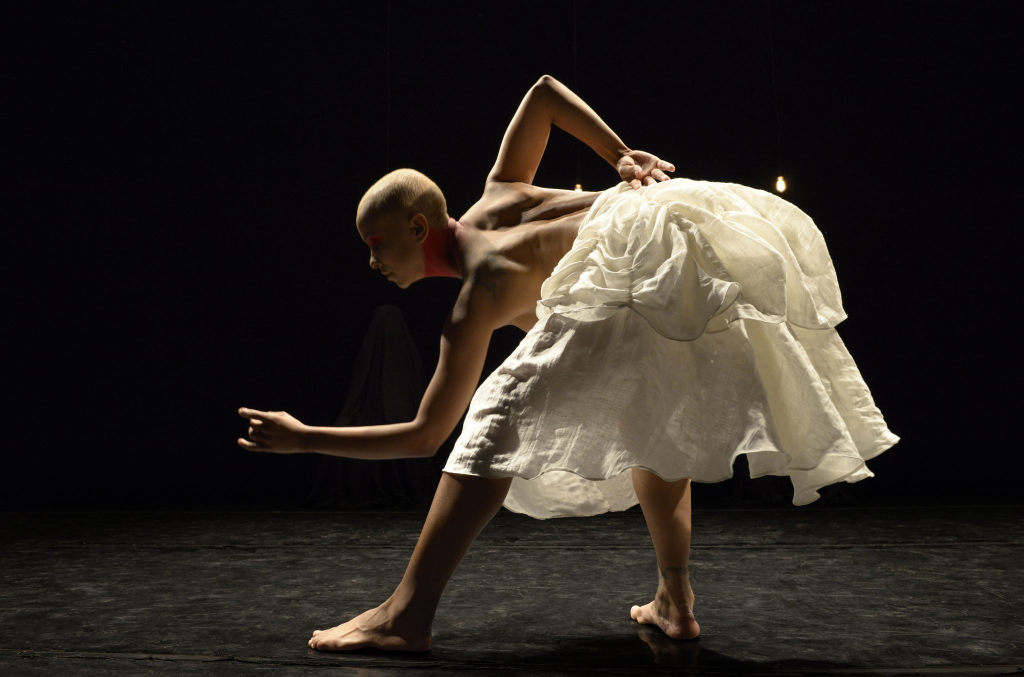
21 and Gira
Grupo Corpo
Zellerbach Hall
University of California, Berkeley
Gyres of Eshu
A review by Christopher Bernard
Cal Performances (the Bay Area’s most adventurous promoter of dance, music and live performance) delivered once again one late weekend in April, as part of its Illuminations: “Fractured History” series: Brazil’s formidably gifted dance company, Grupo Corpo.
Based in Brazil’s legendary Minas Gerais, and founded in Belo Horizonte in 1975, the company is driven by the synergistic talents of two brothers, Paulo and Rodrigo Pederneiras, house choreographer, and director and set and lighting designer, respectively, who have created, with their collaborators, an aesthetic that blends classical ballet and the complex heritage of Brazilian culture, religious and ritual traditions, the whole leavened by a musical culture that is wholly unique.
The company brought two ambitious dances to Berkeley’s Zellerbach Hall. The first was their breakout dance, from 1992, which put the company securely on the international dancing “map”: 21, a number that retains an enticing mystery to it. It also introduced one of the company’s musical signatures: the music and instruments of Marco Antonio Guimarães and the artists of the Uakti Instrumental Workshop. These last not only have a unique armamentarium of instruments, but even use their own microtonal scales, unless my ears were fooling me—essential elements of what makes the company’s work uniquely engaging.
21 was groundbreaking: a slow burn that used the entire company in a processus of simple chthonic motives, closely gripping the floor like the movements of wary but defiant jungle animals, on dancers at first dressed entirely in yellow bodysuits against a pitch-black background, appearing at first behind a misty transparent screen that creates a ghost-like effect, and rising midway through the work as the dance moved to illumination from mystery.
The dance began with a hypnotic monotony of group motions with slight variations against a polyphony of percussion and string and blown instruments entirely new to this listener’s ear, and gradually morphed into a succession of solos and increasingly elaborate duos, trios, and corps, by turns haunting, raunchy, and carnivalesque, until its energies, long simmering, boiled over and broke out into a joyously orgiastic conclusion that brought the Brazilian gods to the stage and the local audience to their feet.
The imaginative use of lighting and color, as well as the costume designs (which transmogrified from the monotone to the wildly polychrome) of Freusa Zechmeister, were as vital to the overall effect as motion and music.
The second dance, Gira (“Spin”), from 2017, takes the elements of spiritualist rite suggested in 21 and brings them unapologetically to the fore. The dance is based on the rituals of Umbanda (a merging of West and Central African religions such as Yoruba with Catholicism and spiritism) to the music of the jazz band Metá Metá and vocals from Nuno Ramos and Eliza Soares. The dance is based on rituals calling forth the spirit of Eshu, a deity who acts as a bridge between humanity and the world of the orixás of Ubamba, Condomblé, and the spiritualities they have in common. Eshu commands and drives the rite of the giras, or spinning, whose motions, like those of the dervishes of Islam, open the dancers to the gods and the gods to the dancers.
Gira evolved as a series of variations on the motions of the ritual, increasingly fugal, danced by the performers as if in the trance that the ritual aims, paradoxically, both to create and to emerge from. Both male and female dancers wore long white skirts and were bare breasted in a show of a curious mixture of vulnerability, beseeching, and seduction to bring forth the divine.
It’s a beautiful and evocative work, if overstaying just a little.
Not to be forgotten is the technical brilliance of the dancers themselves: masters of their gifts, and sharpened by the equal mastery of the company’s leadership.
____
Christopher Bernard is an award-winning novelist, poet, and essayist and author of numerous books, including A Spy in the Ruins (celebrating its twentieth anniversary in 2025) and The Socialist’s Garden of Verses. He is founder and lead editor of the webzine Caveat Lector and recipient of an Albert Nelson Marquis Lifetime Achievement Award.
